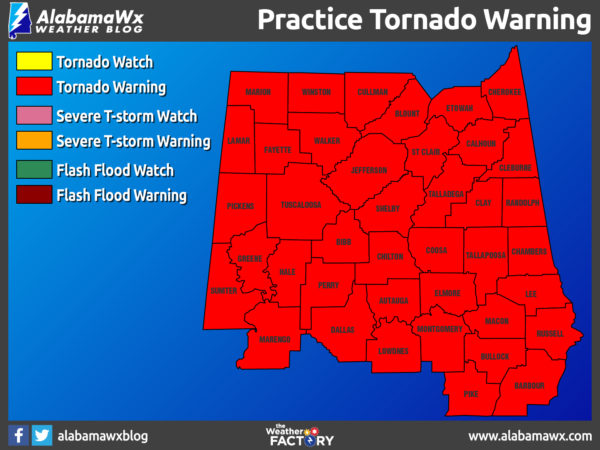Did You Hear This Morning’s Practice Tornado Warning?
This morning, as part of Severe Weather Awareness Week in Alabama, the NWS in Birmingham issued a practice tornado warning in the form of a NOAA Weatheradio test just after 9 a.m.
Did you hear the warning? If so, good!
If not, perhaps you leave your NOAA Weatheradio off much of the time. Not good! NOAA Weatheradio is a key component in your program of having redundant sources of watches and warnings. Having your radio programmed and set to alert mode at all times is a great way to make sure you never miss a warning situation.
Weatheradio alarms sound for entire counties unfortunately, while actual warnings are generally smaller portions of counties. But Weatheradio is reliable and not prone to telephone system congestion. And it wakes you in th emiddle of the night.
Pair Weatheradio with other sources, like the WDT Weather Radio App or WeatherCall to form your first line of defense in severe weather protection!
This week is Severe Weather Awareness Week in Alabama. It’s a time to brush up or learn about severe weather and to make sure that you and your family have a good plan for when severe weather occurs.
As a part of that, the National Weather Service in Birmingham has issued a practice tornado warning for all of their area of responsibility in Central Alabama. An alert was sent over NOAA Weatheradio. Some counties are sounding their sirens. Since the NWS did not officially issue a tornado warning, most apps did not activate. Did you hear an alert or a siren?
A GOOD TIME TO CONSIDER HOW YOU GET YOUR WARNINGS
Outdoor sirens are designed to warn people who are outside that there is a tornado warning. They usually sound county wide, rather than just in areas where the warning is in effect, which means a lot of false alarms. And they generally can’t be heard indoors and won’t wake you when you are asleep, so don’t rely on them as a primary line of defense in your severe weather safety plan.
NOAA Weather Radio is a reliable way to receive warnings. When a watch or warning is issued by the National Weather Service, specially built receivers are automatically activated and sound a loud alarm. They can be programmed for specific counties. The drawback is that, like sirens, they sound for entire counties, not the very specific areas included in the NWS storm based warning. But Weather Radio is a robust, reliable way of getting the message when severe weather threatens, and should be part of your redundant method to get warnings.
If you have an iOS or Android device, we recommend WeatherRadio by WDT. It sounds an alarm when specified watches and warnings are issued for your location.
We will be posting all severe weather warnings for North and Central Alabama on AlabamaWX along with other detailed forecast information. So while we are not the source to wake you in the middle of the night, we hope you will turn to us for more information, once you are in shelter!
KNOW THE DIFFERENCE BETWEEN A WATCH AND A WARNING
A watch means that conditions are favorable for severe weather, including tornadoes, severe thunderstorms or flooding. During a watch, you should monitor your warning sources carefully and review your safety plan.
A warning means severe weather is occurring or is about to occur. TAKE ACTION IMMEDIATELY! You may have only minutes or seconds to get to a safe place.
HAVE A PLAN AND USE IT!
Take time to familiarize yourself with severe weather safety rules. Our comprehensive list of tips is organized by places you might be during a warning (home, car, etc).
You need to have a basic plan for the different places you might be. Here are some things that you need to consider when you make your plan:
- Think about the place you will go on a moment’s notice if severe weather strikes.
- Pick a place where family members can gather: the basement, bathroom, an interior hallway or closet on the lowest floor.
- Make sure your home, school, workplace and church have a designated shelter.
- Pay attention to weather information during the risk.
- Have redundant sources of weather warnings.
- Notify friends and family who may not be aware.
- Have shoes, wallet, emergency kit and phone close by so you can grab them on a moment’s notice.
- Keep important documents such as copies of insurance policies, identification and bank account records in a waterproof, portable container.
- Don’t forget your pets: collars with identification, sturdy leashes, food/drinking water/bowls, cat litter/pan, pet beds and toys.
- Do drills with your family. Include pets.
Every family should have an emergency supply kit. Some items to consider.
- Battery powered radio and Weatheradio with extra batteries
- Flashlight and batteries
- First aid kit
- Bottled water for people and pets. Try to have one gallon per person per day that you expect to be isolated.
- Energy food, including nuts and energy bars
- Bike or football helmets
- Baby supplies including diapers, food and formula
- Air horn or whistle to signal rescuers
Download this checklist from FEMA for more ideas.
Finally, make sure sure your family knows where their safe places are and what they should do in various situations. Have a prearranged meeting spot for before and after the storm. Know how you will contact each other.
Category: Severe Weather



















